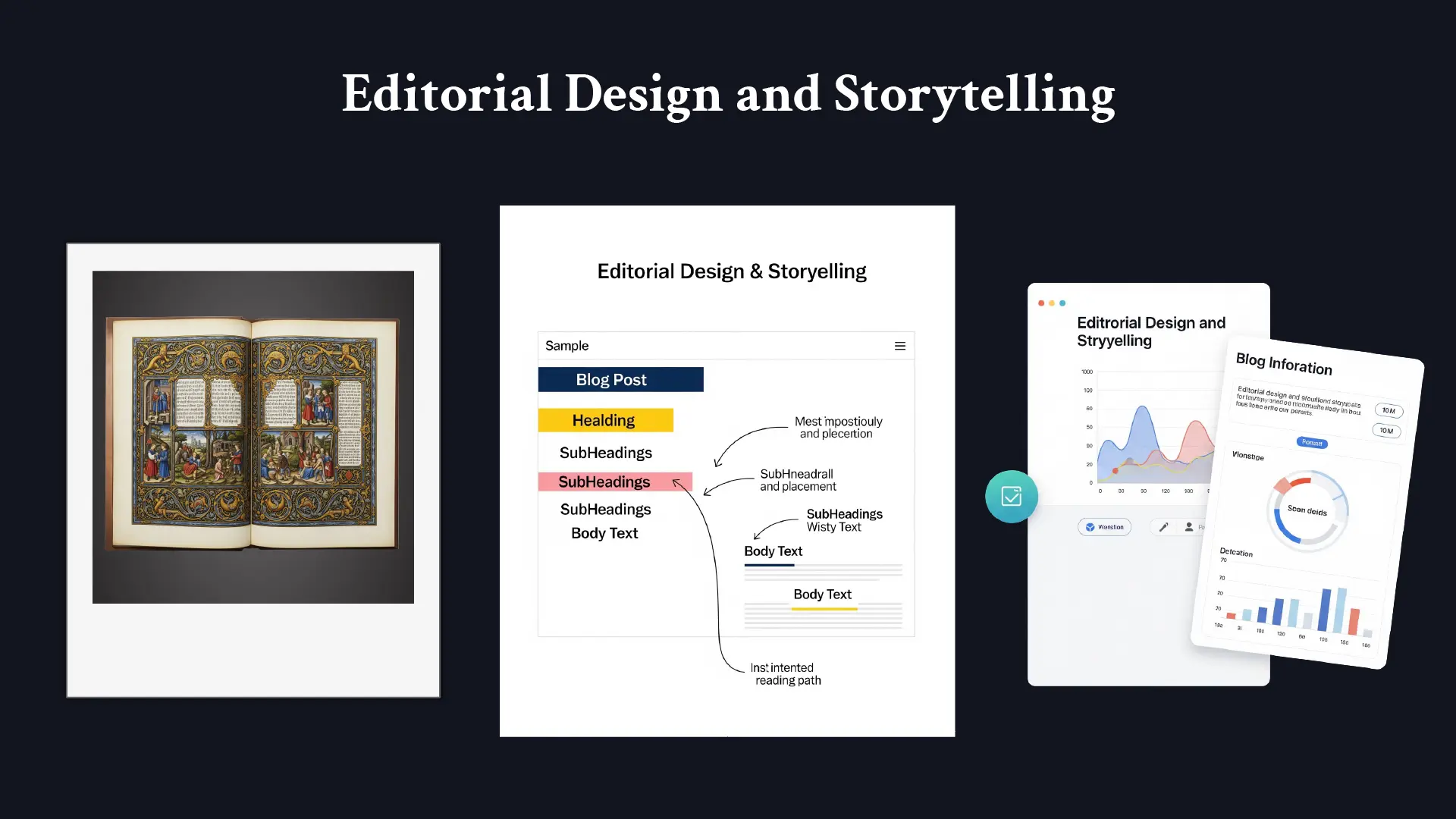
At TiP (Text in Process), we understand that desktop publishing is more than just arranging text on a page. It’s about crafting experiences, guiding the reader through information, and ultimately, telling a story. Editorial design, the art and science of structuring and styling content for publications, has always been intrinsically linked to the power of narrative. From the earliest illuminated manuscripts to today’s dynamic digital magazines, visual elements work in concert with written words to shape understanding, evoke emotion, and leave a lasting impact. In this post, we’ll delve into the fascinating relationship between editorial design and storytelling, exploring its historical roots and contemporary applications.
The Genesis of Visual Narrative
Long before the advent of the printing press, stories were meticulously crafted and preserved in handwritten manuscripts. These weren’t simply blocks of text; they were visual feasts. Illuminated letters, intricate borders, and vivid illustrations weren’t mere decoration; they served as crucial narrative devices. They highlighted key moments, clarified complex ideas, and added layers of meaning to the text. Consider the Bayeux Tapestry, a sprawling visual narrative recounting the Norman Conquest. While not a book in the traditional sense, its sequential imagery and accompanying Latin inscriptions demonstrate the inherent human desire to tell stories visually. These early examples highlight a fundamental principle: visual elements are powerful tools for engaging audiences and conveying information in a compelling way.
The Printing Revolution and the Rise of Editorial Conventions
The invention of movable type marked a significant shift, allowing for wider dissemination of information and the development of more standardized editorial practices. Early printed books, while less ornate than their manuscript predecessors, still relied on visual hierarchy to guide the reader. Title pages announced the narrative, chapter headings demarcated its structure, and woodcut illustrations provided visual anchors within the text. As printing technology evolved, so too did the sophistication of editorial design. The rise of newspapers and magazines in the 18th and 19th centuries saw the emergence of distinct layouts, typography, and the strategic use of images to capture attention and organize information for a wider audience. The visual language of storytelling was becoming more formalized, with designers consciously employing elements to create flow, emphasis, and visual interest.
Theoretical Foundations: Guiding the Reader’s Eye
Modern editorial design draws upon a rich body of theoretical principles to enhance storytelling. Concepts like visual hierarchy, established through variations in typeface, size, and placement, guide the reader’s eye through the content, highlighting key information and creating a clear sense of structure. The strategic use of whitespace, often referred to as negative space, provides visual breathing room, improves readability, and can even contribute to the overall mood and pacing of the narrative. Grid systems provide an underlying framework, ensuring consistency and visual harmony across pages, allowing readers to navigate the information intuitively.
Typography, the art of selecting and arranging typefaces, plays a crucial role in conveying tone and personality. A serif typeface might evoke a sense of tradition and authority, while a sans-serif font could suggest modernity and clarity. The choice of imagery, its placement, and its relationship to the text are equally vital. Photographs, illustrations, and infographics can provide visual evidence, evoke emotions, and simplify complex data, enriching the reader’s understanding of the story. Consider the impact of a powerful photograph accompanying a news article or the way illustrations can bring a fictional world to life in a magazine feature.
Crafting Visual Narratives in the Digital Age
The digital revolution has ushered in a new era of editorial design, offering unprecedented opportunities for dynamic and interactive storytelling. Online publications can leverage multimedia elements like video, audio, and interactive graphics to create immersive experiences. Responsive design ensures that narratives adapt seamlessly across different devices, maintaining visual coherence and readability regardless of screen size. The principles of visual hierarchy, whitespace, and typography remain crucial, but designers now have a broader palette of tools to engage readers and guide them through complex digital landscapes.
Consider the long-form storytelling that has flourished online, where scrolling becomes a narrative device, revealing information in carefully orchestrated sequences. Interactive data visualizations allow readers to explore information at their own pace, uncovering layers of the story through engagement. The challenge for editorial designers in the digital age is to harness these new technologies while remaining true to the fundamental principles of clear communication and compelling narrative.
Conclusion: The Enduring Power of Visual Storytelling
From the intricate artistry of illuminated manuscripts to the dynamic interactivity of modern digital publications, editorial design has always been an indispensable partner in the art of storytelling. By understanding the theoretical foundations of visual communication and embracing the evolving possibilities of technology, designers at agencies like TiP can craft compelling visual narratives that inform, engage, and leave a lasting impression on the reader. The power of a well-designed publication lies not just in the words it contains, but in the thoughtful and deliberate way those words are presented alongside visual elements, creating a cohesive and impactful storytelling experience. We believe that at the heart of effective desktop publishing lies a deep appreciation for the art and science of guiding readers through a story, and that is a principle that continues to drive our work at TiP.
